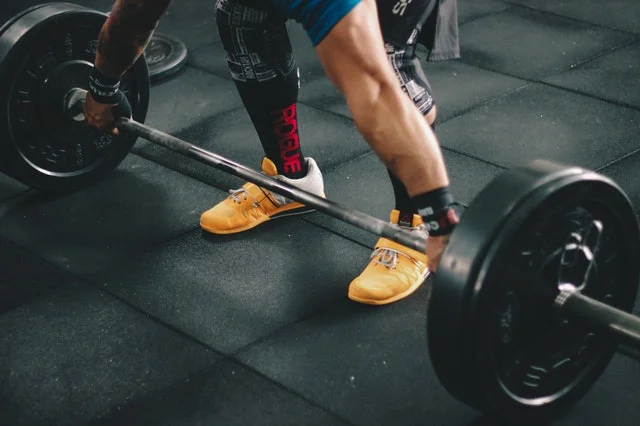Strength Training for a Better Vertical Jump
How to improve functional lower body muscular development and your jump height
The vertical jump (VJ) is a great potential gauge for athletic potential across many sports. Muscular factors associated with VJ such as force, power and the rate of force development can be likened to other athletic indicators such as short distance sprint speed, lower body strength & power and an effective change of direction, not to mention the benefits in regards to injury prevention. This article reviews training methods to determine which can most effectively improve an individual’s functional lower body development and vertical jump height.
The first study (1)* investigates the effects of weightlifting and kettlebell training on VJ height and max strength, tested by a counter movement jump (CMJ) and 1RM back squat (Otto, Coburn, Brown, & Spiering, 2012). The exercises chosen all utilized a triple extension movement pattern (ankles, knees and hips) however, the workload varied depending on the exercise. The results showed that both weightlifting and kettlebell training were effective in increasing maximal strength and power. While there were no distinguishable differences in vertical jump between the two training methods, there was a significant improvement in muscular strength from the weightlifting group.
Another important factor contributing towards athletic performance, is specificity. This is why the following study (2)* compares a weightlifting program to a vertical jump focused, plyometric program. This study was tested by comparing squat jump (SJ), 10-m sprint speed (SS), countermovement jump (CMJ) and 1RM half squat (HS) (Tricoli, Lamas, Carnevale, & Ugrinowitsch, 2005). The weightlifting group showed statistically significant improvements across all 4 testing measures (9.56%, 3.66%, 6.6% and 47.8% respectively). The plyometric group also boasted improvements across the board, however, only 2 measurements were statistically relevant. These were CMJ (5.72%) and HS (43.7%).
This final study (3)* looked at a 12-week, in season program with elite level, male, handball players (Carvalho, Mourão, & Abade, 2014). When combining a plyometric with a traditional strength training program, the athletes experienced a significant improvement in squat jump, countermovement jump and 40-consecutive jump tests (6.1%, 3.8% and 6.8%). In addition to this, the athletes saw a decrease in fat mass (15.7%) and an increase in lean mass (2.1%). Considering these were well trained athletes, who were already in-season, these numbers are very impressive.
In conclusion, it appears that most well-constructed resistance training programs will produce improvements in functional lower body muscular development and jump height. While this is the case, it is suggested that heavier weighted methods such as weightlifting will generate more optimal results, when compared with bodyweight or kettlebell training. It is however important to note the effectiveness of combining both resistance training and plyometric training methods. This is most likely due to the increases in muscular force & power, the rate of force development, muscle contraction velocity, muscle cross-sectional area and neural adaptations (Perez-Gomez & Calbet, 2013). Another factor to consider is the overall loss of body and fat mass in some athletes. If this can be done in conjunction of improving lean body mass, the athlete will potentially experience a greater relative power output.
1 ) Training Methods (Otto, Coburn, Brown, & Spiering, 2012).
Each group trained 2 times per week, for 6 weeks, with a linear periodization model.
The kettlebell group performed kettlebell swings, accelerated swings and goblet squats.
The weightlifting group performed high pulls, power cleans and back squats.
During weeks 1-3, the sets and reps were 3x6, 4x4 & 4x6 for respective exercises.
During weeks 4-6, the sets and reps were 4x6, 6x4 & 4x6 for respective exercises.
2) Training Methods (Tricoli, Lamas, Carnevale, & Ugrinowitsch, 2005).
The training program went for 8 weeks.
The weightlifting group performed High pulls, power cleans and clean & jerks.
The plyometric group performed double leg hurdle hops, alternated single-leg hurdle hops, single-leg hurdle hops and 40cm drop jumps.
The sets and reps for the weightlifting group were 3x6, 4x4 & 4x4 for respective exercises.
The sets and reps for the plyometric group were 6x4, 4x4, 4x4 & 4x4 for respective exercises.
3) Training Methods (Carvalho, Mourão, & Abade, 2014).
12-week training program.
Weeks 1-3, 2 sets of 15-20 reps at 60-75% of 1RM. The exercises consisted of leg press, leg extension, leg flexion, standing calf raise, lower back extensions, barbell squats and barbell lunges.
Weeks 4-7, 3 sessions per week, 2 sets of 8-12 reps at 75-80% of 1RM. Exercises included leg press, leg extension, leg flexion and standing calf raises.
Weeks 8-12, 3 sets of 12 reps (plyometric program). Exercises included hurdle jumps, lateral multi-jumps and frontal multi-jumps.
References:
Carvalho, A., Mourão, P., & Abade, E. (2014). Effects of Strength Training Combined with Specific Plyometric exercises on body composition, vertical jump height and lower limb strength development in elite male handball players: a case study. In Journal of Human Kinetics (Vol. 41, pp. 125-132).
Otto, W. H., Coburn, J. W., Brown, L. E., & Spiering, B. A. (2012). Effects of weightlifting vs. kettlebell training on vertical jump, strength, and body composition. Journal of Strength & Conditioning Research, 26(5), 1199-1202. doi:10.1519/JSC.0b013e31824f233e
Perez-Gomez, J., & Calbet, J. A. (2013). Training methods to improve vertical jump performance. Journal of Sports Medicine & Physical Fitness, 53(4), 339-357.
Tricoli, V., Lamas, L., Carnevale, R., & Ugrinowitsch, C. (2005). Short-term effects on lower-body functional power development: weightlifting vs. vertical jump training programs. The Journal of Strength & Conditioning Research, 19(2), 433-437.
Written by Nevin Mills - The Strength Institute of Western Australia



